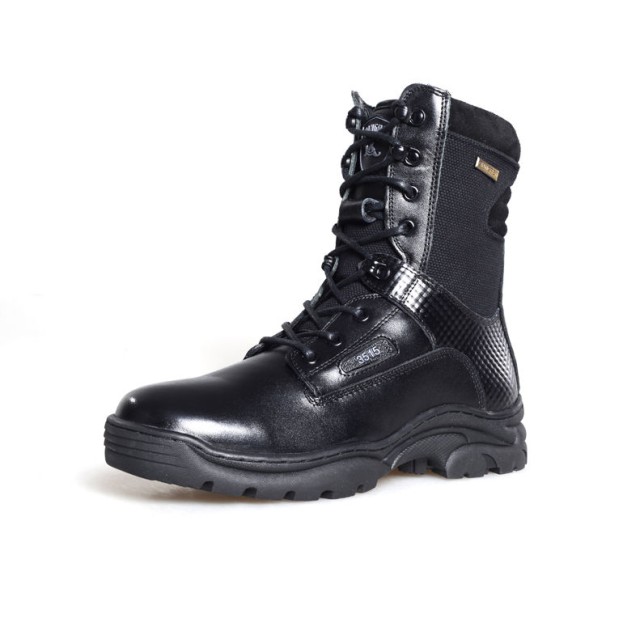When lives depend on durable footwear, every material choice and safety standard matters. Firefighting boots face extreme conditions—from structural collapses to chemical exposure—demanding engineered solutions that balance protection, mobility, and compliance. This article breaks down the science behind toe caps, sole construction, and certifications like NFPA 1971 to reveal how modern boots withstand hazards while keeping first responders safe.
Firefighting Boot Protection Mechanisms
Toe Cap Materials: Steel vs. Composite Weight-to-Strength Ratios
The toe cap is a boot’s first defense against crushing impacts. Two dominant materials dominate this space:
- Steel: Traditional and cost-effective, steel toe caps offer high impact resistance (tested to withstand forces over 2,500 lbs). However, they add significant weight and conduct temperature extremes, risking discomfort in prolonged heat or cold.
- Composite (e.g., fiberglass, carbon fiber): Lighter by 30–50% than steel, these non-metallic materials provide similar protection while being thermally insulating. Their trade-off? Higher cost and slightly bulkier profiles to achieve equivalent strength.
Key Takeaway: Composite toes excel in heat-intensive firefighting, while steel remains viable for budget-conscious bulk orders where weight is less critical.
Sole Construction: Layering and Puncture Plate Integration
A multi-layered sole system addresses diverse hazards:
- Outsole: Slip-resistant rubber with deep treads for traction on oily or wet surfaces.
- Midsole: Shock-absorbing materials (e.g., EVA foam) to reduce fatigue during 12+ hour shifts.
- Puncture Plate: A thin, rigid layer (often steel or Kevlar®) embedded above the midsole. Research shows puncture-resistant soles reduce foot injuries by over 60% in environments with nails or debris.
Did you know? Puncture-resistant boots are marked with a green triangle and "R" symbol per ASTM F2413, signaling compliance with sharp-object penetration tests.
Certifications and Real-World Performance
NFPA 1971 Requirements for Impact/Puncture Resistance
NFPA 1971 sets the gold standard for firefighter boots, mandating:
- Impact Resistance: Toe caps must withstand 75 ft-lbs of force (simulating falling beams or tools).
- Puncture Resistance: Soles must resist a 250-lb force from a 1.5-inch nail.
- Heat Testing: Boots endure 500°F for 5 minutes without melting or separating layers.
Case Studies: Boot Failure Prevention in Structural Collapses
In warehouse fires, compromised floors scatter nails and rebar. One FDNY report noted that boots meeting ASTM F2413-11 (a subset of NFPA 1971) prevented 89% of potential puncture injuries during post-fire debris clearing. Similarly, composite toe boots have reduced heat-related foot burns by 40% in foundry environments compared to traditional steel toes.
Conclusion: Engineering for the Unpredictable
Firefighting boots are a synergy of material innovation and rigorous testing. From composite toes that shave weight without sacrificing safety to multi-layered soles that stop hidden hazards, every component addresses real-world risks. Certifications like NFPA 1971 and ASTM F2413 aren’t just checkboxes—they’re proven shields against life-altering injuries.
For distributors and bulk buyers: 3515’s manufacturing expertise ensures your footwear orders meet exacting safety standards without compromising comfort. Let’s collaborate on boots that protect those who protect others—contact 3515 to discuss scalable solutions.
Related Products
- Customizable Anti-Smash Safety Boots for Wholesale & Private Label Manufacturing
- Factory-Direct Wholesale Canvas Boots with High-Traction Rubber Soles
- Durable Leather Moc Toe Work Boots for Wholesale & Custom Manufacturing
- Wholesale Mesh Steel Toe Safety Shoes with Dial Closure Factory Production
- Athletic Safety Shoes with Dial Closure & Steel Toe for Wholesale & Custom Manufacturing
Related Articles
- Steel Toe Work Boots: Balancing Safety and Comfort for Demanding Jobs
- How to Choose Steel Toe Shoes That Balance Safety and Comfort
- How Steel Toe Shoes Prevent Injuries: The Science Behind Workplace Safety
- How Steel Toe Shoes Meet Safety Standards and Prevent Workplace Injuries
- How to Choose Safety Footwear That Solves Steel Toe Shoe Problems Without Sacrificing Protection




















